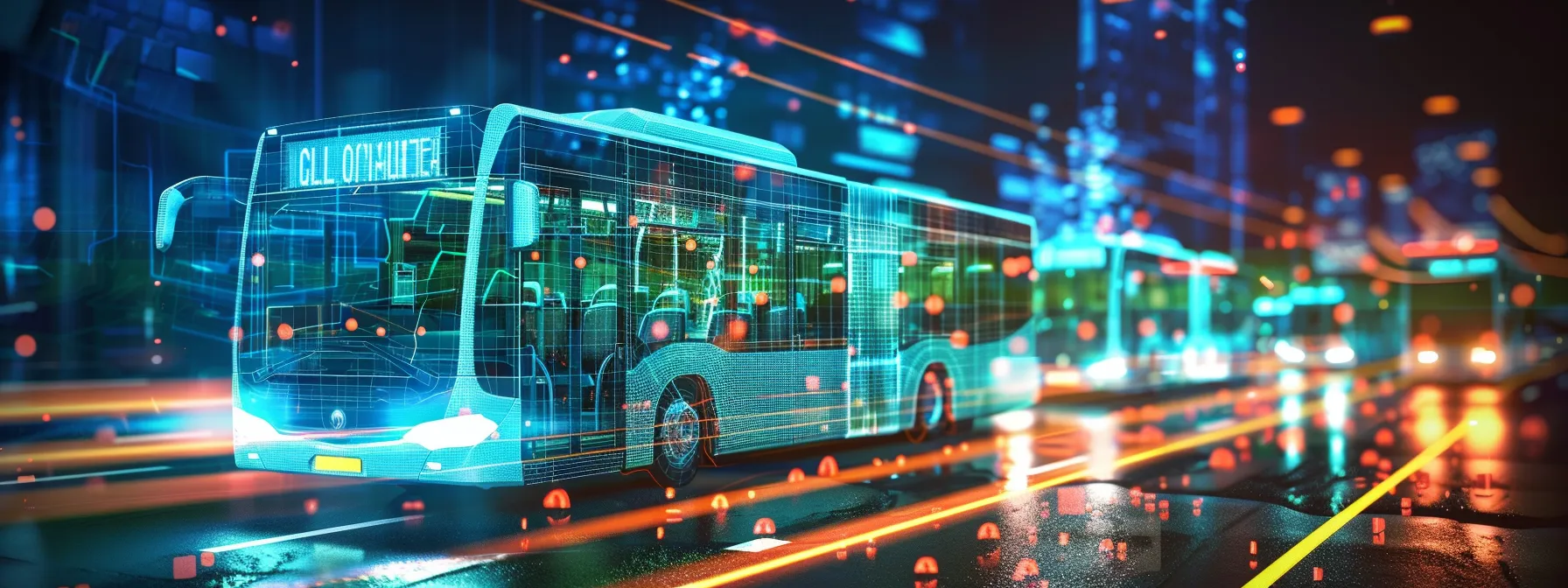
Achieving Greater Safety in Transit via Advanced Computer Vision

Achieving Greater Safety in Transit Through Computer Vision
Transit safety reaches a new level with computer vision. This post presents how computer vision technology improves transport safety and outlines the integration of advanced AI systems and best practices. It details regulations affecting computer vision in transit and evaluates cost-effectiveness. Readers will gain insights on solving safety concerns and making informed decisions for their projects.
Key Takeaways
- Digital Fractal integrates computer vision and iot with mobile app development for transit safety
- Computer vision systems improve hazard detection and trigger immediate braking in transit vehicles
- Machine learning models analyze critical transit points for real-time safety monitoring
- Funding options, including government grants, lower upfront costs and boost safety investments
- Continuous training and system inspections support efficient transit operations and regulatory compliance
Leverage Computer Vision Technology for Transport Safety Enhancements
This section outlines the basics of computer vision applications in transit, highlights key benefits for transport safety, presents effective case studies, and discusses common hurdles. It provides insight into future technology trends, license management, forecasting improvements, and warehouse roles, ensuring readers grasp practical safety advancements in transit.
Understand the Basics of Computer Vision Applications in Transit
Digital Fractal illustrates how computer vision applications in transit blend technology with safety measures by integrating mobile app development and the internet of things to optimize rail transport operations. The use of telecom networks supports efficient data flow, enabling agents to track performance and address issues with rapid acceleration in response times. This approach offers a straightforward and reliable framework that helps stakeholders ensure secure travel environments.
Identify Key Benefits of Computer Vision in Improving Safety
Computer vision delivers notable safety improvements by refining perception capabilities essential for identifying hazards and triggering brake systems on buses and other transit vehicles; its integration with edge computing ensures immediate emergency responses, thereby reducing risks during critical situations:
| Key Benefit | Description |
|---|---|
| Improved Perception | Accurate, real-time hazard identification supports decision-making in transit operations. |
| Emergency Response | Rapid detection facilitates prompt actions in emergency scenarios on transit vehicles. |
| Brake Activation | Systems engage braking mechanisms instantly to prevent collisions during unforeseen obstacles. |
| Edge Computing | Optimizes data processing near the source for swift performance analysis and response. |
| Bus Safety | Tailors safety features specifically to bus transit environments, ensuring robust protection. |
Analyze Case Studies Showcasing Effective Implementations
Case studies from various transit projects demonstrate that computer vision enhances operational safety by enabling precise parameter monitoring and informed design adjustments, directly addressing critical traffic issues while safeguarding personal data. Industry literature supports this approach, offering practical examples that guide developers and decision-makers through effective implementation strategies tailored to transit environments.
Discuss Common Challenges During Computer Vision Implementation
Computer vision implementation in transit may encounter obstacles when integrating modern technology with existing asset infrastructures, managing fuel and energy data effectively, and meeting urban planning and policy guidelines:
- System integration with legacy transit platforms
- Data synchronization for fuel consumption and energy efficiency
- Challenges in urban planning and installation logistics
- Ensuring accurate asset tracking throughout deployment
- Adherence to evolving policy standards in transportation safety
Integrate Advanced AI Systems to Strengthen Safety Measures
Exploring AI techniques for detecting transit hazards brings improved accuracy, while machine learning models strengthen safety monitoring and real-time data analysis. Recognized success stories illustrate AI as the engine behind preventive measures, ensuring adherence to standards, reducing energy consumption, optimizing dynamic pricing, and enabling efficient asset management in transit systems. Artificial Intelligence services
Examine AI Techniques That Improve Detection Accuracy in Transit
Digital Fractal’s AI techniques improve detection accuracy by employing machine learning models that analyze critical transit points such as intersections and busy port areas, effectively managing the pressure caused by sudden environmental changes within the urban landscape. These techniques support ongoing evolution in transit safety and offer actionable insights beneficial for reducing risks and ensuring secure travel environments:
| Method | Application | Impact |
|---|---|---|
| Machine Learning | Pressure monitoring at intersections | Enhanced accuracy in hazard detection |
| Image Analysis | Surveillance at port areas | Immediate response to emerging risks |
Explore Machine Learning Models Used in Safety Monitoring
Digital Fractal experts analyze machine learning models used in safety monitoring to address bias while improving the performance of systems that serve sectors such as retail, autonomous vehicles, and public transport; their method supports digital transformation by delivering actionable insights that reduce errors and streamline transit operations:
| Model Type | Application | Sector Impact |
|---|---|---|
| Supervised Learning | Hazard detection in transit systems | Public transport |
| Unsupervised Learning | Pattern recognition while reducing bias | Retail operations |
| Reinforcement Learning | Optimizing actions in autonomous vehicles | Digital transformation |
The approach offers a clear pathway for stakeholders to upgrade safety measures and supports data-driven decisions that improve reliability and oversight in modern transit networks.
Assess the Role of Data Processing for Real-Time Analysis
Digital Fractal utilizes advanced data processing to provide real-time analysis that detects anomalies in transit systems, including monitoring performance at a bus stop. The system evaluates operational behavior against the concept of sustainable transit, helping stakeholders measure efficiency improvements while reducing both the ecological footprint and carbon footprint of their operations.
Highlight Success Stories of AI in Accident Prevention
Recent initiatives demonstrate that AI systems employing synthetic data and robust mathematics serve as a vital tool in updating transit safety protocols. The integration of these advanced systems strengthens the transit infrastructure and creates an effective ecosystem that quickly addresses hazards, leading to reduced accident rates.
Implement Best Practices for Using Computer Vision Solutions
Digital Fractal outlines steps for deploying vision technology with artificial intelligence integration and fleet management protocols. Stakeholders learn to track safety with key metrics, prepare staff for electronics use in last mile operations, and apply maintenance strategies for scalability. This framework sets the stage for detailed discussions on each practical aspect.
Outline Steps for Effective Deployment of Vision Technology
Digital Fractal’s experts demonstrate that effective deployment of vision technology begins with meticulous integration planning and hands-on training to minimize downtime while monitoring consumption, traffic flow, and greenhouse gas levels. This method equips transit operations with actionable insights that improve safety and overall system performance, addressing common challenges with clear, practical solutions.
Identify Key Metrics to Measure Safety Improvements
Digital Fractal experts identify specific safety metrics to track risk reduction and optimize investment returns while fine-tuning logistics in rapid transit systems. They apply ongoing learning to pinpoint actionable insights that enable stakeholders to address challenges effectively and achieve measurable improvements in overall transit safety.
Prepare Staff for Technology Integration and Usage
Digital Fractal ensures that staff are well-prepared through focused training sessions that deepen their understanding of data analysis and knowledge extraction techniques for effective traffic management. The comprehensive program equips team members to manage big data efficiently, providing clear, actionable insights that directly address operational challenges in transit safety.
Discuss Maintenance Strategies to Ensure Continuous Operation
Digital Fractal maintains continuous operation by scheduling regular inspections and system updates that include checks on radar sensors, ensuring that potential faults are detected early. Their approach prioritizes efficient energy use and fuel efficiency by integrating renewable energy techniques, as demonstrated in projects across singapore, which helps sustain safety measures in transit systems.
Analyze Regulations That Impact Computer Vision in Transport
Industry experts review current transportation safety regulations for regulatory compliance. They examine future trends in smart city vision technology, utilize ibm predictive analytics for specific data privacy standards, and detail approval processes for novel safety technology innovations through internet-based solutions. This approach offers practical insights for improving transit safety.
Review Current Transportation Safety Regulations for Compliance
Digital Fractal reviews transportation safety regulations through a science-based approach, ensuring that its computer vision solutions comply with standards established by the European Union and guidelines akin to Creative Commons practices. The firm’s experts analyze regulatory changes to determine their trajectory, mitigate potential crime risks, and provide actionable strategies that support safe transit environments.
Explore Future Regulation Trends Affecting Vision Technology
Industry experts foresee future regulatory trends that will drive sharper intelligence integration and rapid speed in processing data, significantly improving transit safety. These trends provide actionable knowledge that refines the overall customer experience while fostering economic growth within urban transport networks. Stakeholders benefit from clear, data-driven measures that ensure their systems remain effective under evolving regulatory standards.
Identify Specific Standards for Data Privacy and Usage
Digital Fractal experts adhere to strict data privacy standards to secure real-time information used by computer vision systems in various transit settings, including truck, tram, and train operations. They implement neural network protocols that meet certification benchmarks similar to those used in tesla autopilot technology, ensuring sensitive data remains protected while maintaining dependable transit safety measures.
Detail Approval Processes for Safety Technology Innovations
Detailing the approval processes for safety technology innovations, Digital Fractal ensures every system undergoes rigorous assessment to align with current transit regulations while verifying autonomy for autonomous buses. The structured process audits each phase from manufacturing to deployment, reducing the risk of fraud and minimizing the overall footprint of the implemented solutions. This careful approach provides stakeholders with actionable insights that support sound investment decisions in transit safety improvements.
Evaluate the Cost-Effectiveness of Computer Vision in Transit
The section compares the startup cost with long-term safety benefits and reduction in accident liabilities while detailing funding options including grants. It explains budgeting strategies for technology adoption. Stakeholders gain improved feedback and data quality to support supply chain optimization, accountability, and supply chain management, ensuring practical savings and enhanced transit safety outcomes.
Compare Initial Investment Versus Long-Term Safety Benefits
Digital Fractal shows that the upfront cost in advanced computer vision systems, integrating lidar and robot technologies, is well balanced by long-term safety benefits in customs operations, ship management, and transit hubs like tokyo. The financial commitment is recouped through measurable risk reduction and operational efficiency gains that deliver lasting value:
- Enhanced hazard detection with real-time data
- Improved performance at customs checkpoints
- Safer ship navigation and transit operations
- Reliable integration of lidar and robot technologies
- Sustainable cost savings and efficiency improvements
Examine Potential Savings From Reduced Accidents and Liabilities
Digital Fractal demonstrates that computer vision technology can help organizations reduce accident-related costs, ensuring smoother order fulfillment and lowering liability risks. The system’s real-time detection capabilities improve safety for bicycles and other transit modes while supporting compliance with the general data protection regulation and contributing to the protection of the natural environment.
Discuss Funding Options and Grants for Safety Projects
Digital Fractal’s funding options offer practical grant strategies and other financial support that equip transit organizations to deploy computer vision systems, improving pedestrian safety and delivering robust analytics and real-time information for modern road transport while helping to reduce carbon impacts:
| Funding Source | Key Benefit |
|---|---|
| Government Grants | Boosts pedestrian safety and refines analytics for improved road transport management |
| Private Investment | Supports recouping initial costs and minimizes carbon footprint impact |
| Institutional Funding | Ensures a steady flow of critical information to advance safety measures in transit |
The clear grant strategies backed by proven financial support provide actionable insights for stakeholders seeking to optimize safety investments in transit systems.
Analyze Budgeting Strategies for Technology Adoption
Digital Fractal experts outline budgeting strategies for technology adoption by combining diligent research with extensive experience in surveillance and commuting safety to ensure investments yield practical, regulation-aligned benefits:
- Examine initial costs compared to long-term efficiency gains.
- Utilize research data to optimize resource allocation.
- Incorporate surveillance insights for iterative safety improvements.
- Adjust budgets to align with evolving regulation and transit trends.
Study the Future of Computer Vision and Transit Safety Innovations
This section examines the future of computer vision in transit safety by predicting trends in vision technology for transport, assessing autonomous vehicle impacts, and reviewing public policy influences while scrutinizing emerging technologies. These insights refine road operations, boost user experience, secure databases from data breach, and support demand forecasting.
Predict Upcoming Trends in Vision Technology for Transport
Digital Fractal anticipates a future where advances in vision technology drive higher predictive maintenance and operational efficiency, allowing transit operators to optimize supply chain protocols and boost customer service performance. Simulation tools offer practical insights that support actionable decisions and measurable system improvements while addressing common safety challenges. The emerging developments pave the way for innovative transit solutions that combine refined system diagnostics with efficient resource management:
| Trend | Impact |
|---|---|
| Predictive Maintenance | Reduces downtime and prevents faults |
| Simulation Tools | Supports scenario planning and resource allocation |
| Customer Service | Improves response times and operational transparency |
| Supply Chain | Streamlines logistics and minimizes delays |
| Operational Efficiency | Boosts overall system performance and safety |
Explore Emerging Technologies That Complement Computer Vision
Innovative systems integrating reinforcement learning with robust energy management offer transit operators precise evaluation tools that refine computer vision applications, unlocking new efficiencies in journey planner solutions. Industry experts highlight the value of detailed pdf reports containing actionable insights, which assist stakeholders in addressing safety concerns while meeting operational needs.
Assess Potential Impacts of Autonomous Vehicles on Safety
Experts observe that autonomous vehicles contribute a significant mass of safety benefits by integrating refined computer vision systems, ensuring timely maintenance and robust decision-making under diverse conditions. They advocate a clear strategy that aligns with sustainable transport objectives, providing transit operators with actionable insights to improve safety outcomes consistently.
Discuss the Role of Public Policy in Shaping Future Safety Initiatives
Public policy shapes transit safety initiatives by establishing standards that guide effective routing and address key research questions on secure operations. By using clear language in regulatory measures and considering factors such as climate change, policymakers boost customer satisfaction and create a foundation for consistent improvements in transit safety.
Frequently Asked Questions
How can computer vision improve transit safety measures?
Computer vision can refine transit safety by identifying hazards, monitoring driver behavior, and detecting obstacles in real-time, thereby fostering efficient decision-making and bolstering public transportation security with advanced automated analysis.
What AI systems support transport safety improvements?
AI systems used in transport safety include algorithms for traffic monitoring, incident prediction, and real-time data integration. Digital Fractal advises businesses on adopting these systems for improved operational readiness and reduced accident risks.
Which practices optimize computer vision solutions in transit?
Robust data preprocessing, tailored neural networks, and precise algorithm tuning serve as best practices for optimizing computer vision solutions in transit, ensuring timely processing and reliable results across varying environments.
What regulations affect computer vision in transport?
Transportation authorities require strict adherence to safety, data privacy, and performance standards when integrating computer vision systems in transport. Compliance with traffic regulations and industry-guided frameworks ensures legal accountability and public protection across automated monitoring applications.
How cost-effective are computer vision solutions for transit safety?
Computer vision solutions provide economical benefits for transit safety by reducing incident response costs and optimizing monitoring processes. Custom integration and support enable transit systems to boost efficiency, ultimately resulting in notable cost savings for technology buyers seeking consultation.
Conclusion
Computer vision boosts transit safety by enabling swift hazard recognition and timely emergency responses. Digital Fractal shows that integrating advanced analytics with machine learning streamlines transit operations and reduces risks. Organizations benefit from accurate detection systems that support real-time decision-making and efficient asset management. Stakeholders gain practical insights that help them adopt cost-effective solutions and strengthen safety protocols in transit systems. Digital Fractal technologies is an Edmonton, Alberta based technology consulting company working on mobile apps, web application, artificial intelligence and cutting edge tech. Contact us for your next project.

